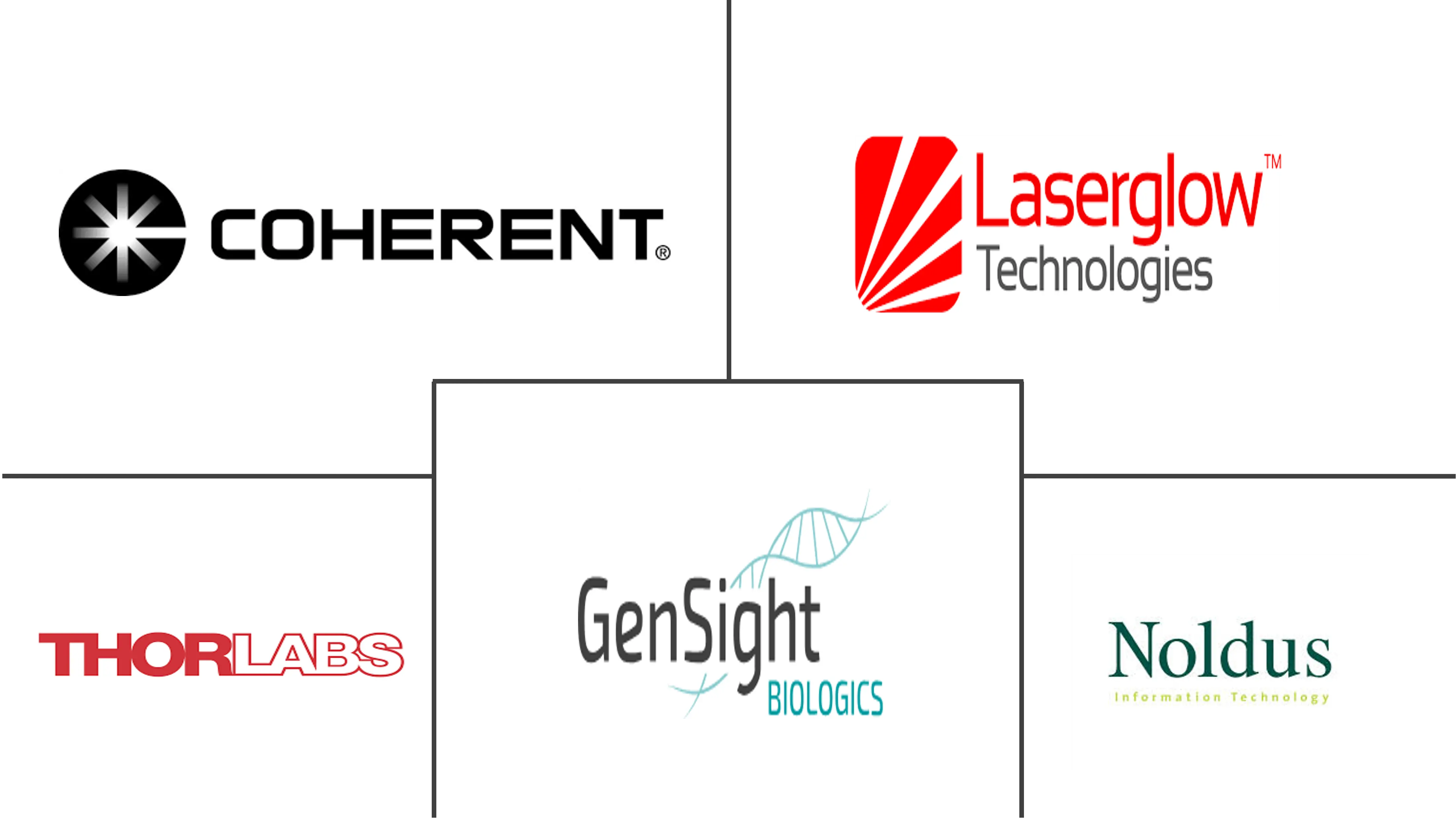Optogenetics Market Size and Share
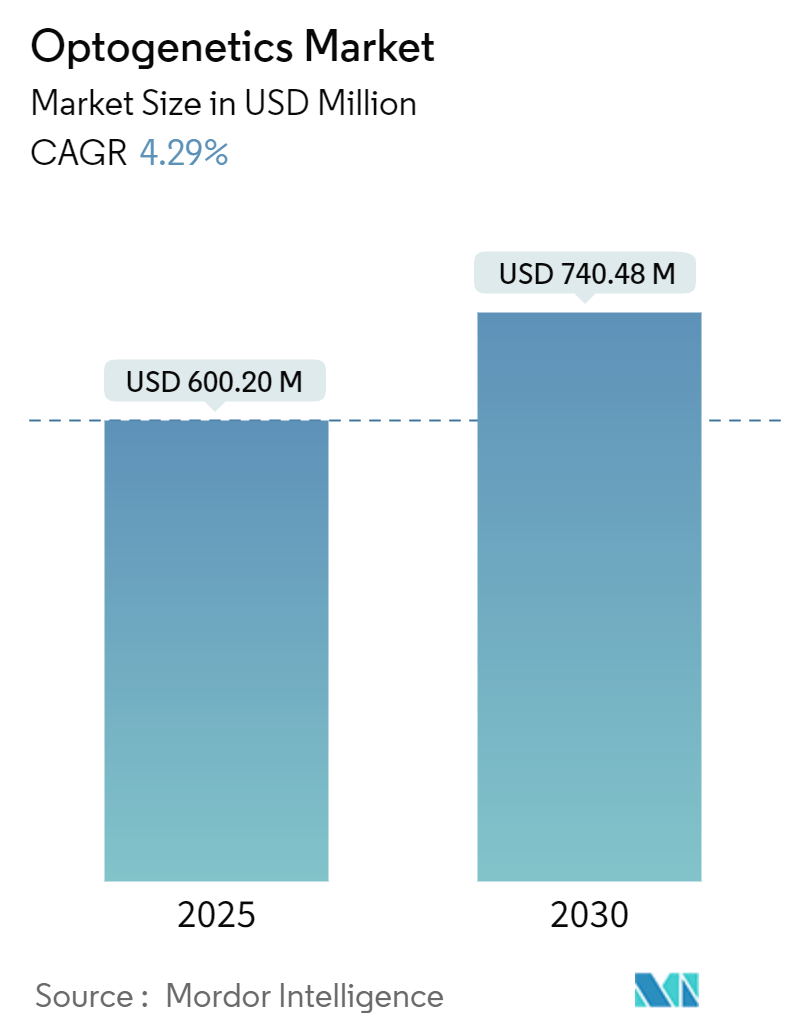
Optogenetics Market Analysis by Mordor Intelligence
The optogenetics market size stands at USD 600.2 billion in 2025 and is forecast to reach USD 740.48 billion by 2030, expanding at a 4.29% CAGR during the period. Venture capital inflows, falling hardware costs, and breakthrough regulatory approvals collectively signal that the technology has transitioned from academic novelty to a platform with therapeutic and industrial utility. North America remains the revenue anchor thanks to sustained NIH BRAIN Initiative grants, yet Asia-Pacific is becoming the bellwether for growth as Japan and China streamline regenerative-medicine pathways. Product demand continues to favor light instruments because compact µLED engines now ship at industrial scale, while sensors experience the fastest uplift as calcium-imaging moves into closed-loop workflows. Competitive intensity stays moderate; photonics incumbents and viral-vector specialists dominate their niches, deterring low-capability entrants. Supply-chain resilience is improving as contract manufacturers invest in larger-scale AAV bioreactors, but capital costs for two-photon systems and ethical scrutiny in human brain trials still temper the growth trajectory.
Key Report Takeaways
By product type, Light Instruments led with 43.19% of the optogenetics market share in 2024, while Sensors are projected to advance at a 4.98% CAGR through 2030.
By application, Neuroscience Research accounted for 43.78% of the optogenetics market size in 2024; Behavioral Tracking & Psychiatry is set to expand at a 4.67% CAGR to 2030.
By end user, Academic & Research Institutes held 47.32% share of the optogenetics market size in 2024, whereas Hospitals & Clinics record the highest projected CAGR at 5.01% through 2030.
By geography, North America commanded 42.03% revenue share in 2024; Asia-Pacific is forecast to post the fastest 5.25% CAGR between 2025-2030.
Global Optogenetics Market Trends and Insights
Driver Impact Analysis
| Driver | (~) % Impact on CAGR Forecast | Geographic Relevance | Impact Timeline |
|---|---|---|---|
| Increasing adoption in neuroscience research | +1.2% | Global, concentrated in North America & Europe | Medium term (2-4 years) |
| Growing clinical pipeline for retinal disorders | +0.8% | North America & EU, expanding to APAC | Long term (≥4 years) |
| Falling cost of compact µLED light engines | +0.6% | Global, led by Asia-Pacific manufacturing | Short term (≤2 years) |
| Venture funding surge in neuro-device startups | +0.5% | North America & EU core markets | Medium term (2-4 years) |
| Regulatory fast-track designations for gene-lighting therapies | +0.4% | U.S. & EU regulatory domains | Long term (≥4 years) |
| Hybrid opto-electro implants enabling closed-loop BCI | +0.3% | North America research centers | Long term (≥4 years) |
| Source: Mordor Intelligence | |||
Increasing Adoption in Neuroscience Research
Large-scale NIH grants now earmark funds specifically for optogenetic recording and modulation platforms, making the technique a default tool in translational studies. Graduate programs teach light-based neural manipulation as a core competency, creating a self-reinforcing talent pipeline that raises baseline demand for turnkey systems. Pharmaceutical firms subsequently recruit these trained investigators to accelerate drug-discovery workflows, driving secondary equipment sales into industry laboratories. The pattern raises utilization rates for consumables such as opsin-expressing vectors, which in turn improves order visibility for contract manufacturers. Broader adoption also prompts standardization initiatives that lower integration costs, further enlarging the addressable optogenetics market.
Growing Clinical Pipeline for Retinal Disorders
Positive two-year Phase 2/3 data for MCO-010 in retinitis pigmentosa demonstrated durable visual acuity gains without external gear, boosting investor confidence in opsin-gene therapies. Bilateral LUMEVOQ injections maintained efficacy for four years, validating long-term safety and encouraging regulators to grant fast-track status. The EMA’s supportive ATMP opinions for OCU410 and OCU410ST underscore Europe’s receptiveness to optogenetic approaches. Collectively, these milestones shorten commercialization timelines, expand reimbursement discussions, and motivate device companies to co-develop miniaturized goggles and light sources tuned for ocular delivery.
Falling Cost of Compact µLED Light Engines
Transfer rates above 100 million units per hour now make µLED wafers economically viable for disposable neural probes. Bandgap-engineered InGaN devices increase external-quantum efficiency, allowing lower power budgets and smaller battery packs. Integrated LED arrays remove the need for optical fibers, simplifying surgeries and reducing infection risk. Hardware cost savings filter downstream into academic labs with constrained capital, widening the optogenetics market penetration in Latin America and Southeast Asia. Equipment vendors respond by bundling LED drivers with software-defined waveform control, creating recurring revenue streams from firmware upgrades.
Venture Funding Surge in Neuro-Device Start-ups
Investors committed USD 55 million to single-round funding for light-controlled biomanufacturing platforms, signaling diversification of optogenetic use cases beyond neuroscience. Brain-computer interface developers closed USD 87 million to pursue human trials that integrate optical stimulation with electrophysiological readouts. Philanthropic organizations such as the Gates Foundation back optogenetic turf, advancing low-cost biologics production for global health. These capital inflows shorten prototype cycles, accelerate regulatory submissions, and expand the commercial talent pool, cumulatively adding half a percentage point to long-term CAGR.
Restraint Impact Analysis
| Restraint | (~) % Impact on CAGR Forecast | Geographic Relevance | Impact Timeline |
|---|---|---|---|
| High capital cost of two-photon systems | -0.7% | Global, particularly affecting smaller institutions | Medium term (2-4 years) |
| Limited viral-vector payload capacity | -0.5% | Global gene-therapy applications | Long term (≥4 years) |
| Ethical & data-privacy concerns in human brain trials | -0.4% | EU & North America regulatory domains | Long term (≥4 years) |
| Scarcity of opsin-delivery IP outside U.S./EU | -0.3% | Asia-Pacific & emerging markets | Medium term (2-4 years) |
| Source: Mordor Intelligence | |||
High Capital Cost of Two-Photon Systems
Multiphoton microscopes such as the Bergamo II retail in the high six-figure USD range, making them unaffordable for many universities. Core-facility sharing models ease access but restrict experimental flexibility and scheduling. While miniature devices like the 2-gram nVista 2P lower barriers, they trade off depth and resolution, leaving a performance gap for deep-brain interrogation. Unless prices drop or leasing models proliferate, demand will concentrate in well-funded institutions, muting near-term revenue growth.
Limited Viral-Vector Payload Capacity
AAV serotypes cap cargo at roughly 4.7 kb, constraining multi-opsin circuits and sophisticated regulatory regions. High-throughput screening and transcriptomic analytics improve yields, yet scale-up still inflates cost of goods sold. Bioreactor upgrades can shave production expenses by up to 61%, but require significant capex that smaller CDMOs resist. Payload bottlenecks thus limit complexity of next-generation therapies, slowing clinical-stage expansions in cardiovascular and metabolic disorders.
Segment Analysis
By Product Type: Light Instruments Cement Revenue Leadership
Light Instruments held 43.19% of the optogenetics market in 2024, affirming the primacy of illumination hardware in both exploratory and clinical workflows. LED arrays dominate because their small footprint allows direct die-bonding onto neural probes, while lasers retain a niche for deep cortical access. The Sensors category posts a 4.98% CAGR, reflecting demand for simultaneous calcium-imaging that completes closed-loop control. Vendors pre-package excitation and detection optics to shrink bench footprints, which boosts sales to teaching labs.
Component advances push unit pricing lower, allowing smaller institutes to adopt basic bundles and broadening the optogenetics market. µLED cost curves mirror smartphone display manufacturing, compressing bill of materials. Meanwhile, bioluminescent optogenetics (BL-OG) threatens to disrupt demand for external light instruments by embedding luciferase fusion proteins that emit internal photons. Suppliers hedge by offering hybrid kits that couple BL-OG reagents with low-power LEDs for protocol flexibility. As a result, the optogenetics market size for light instruments may plateau near the decade’s end even while total system sales rise through accessory components.
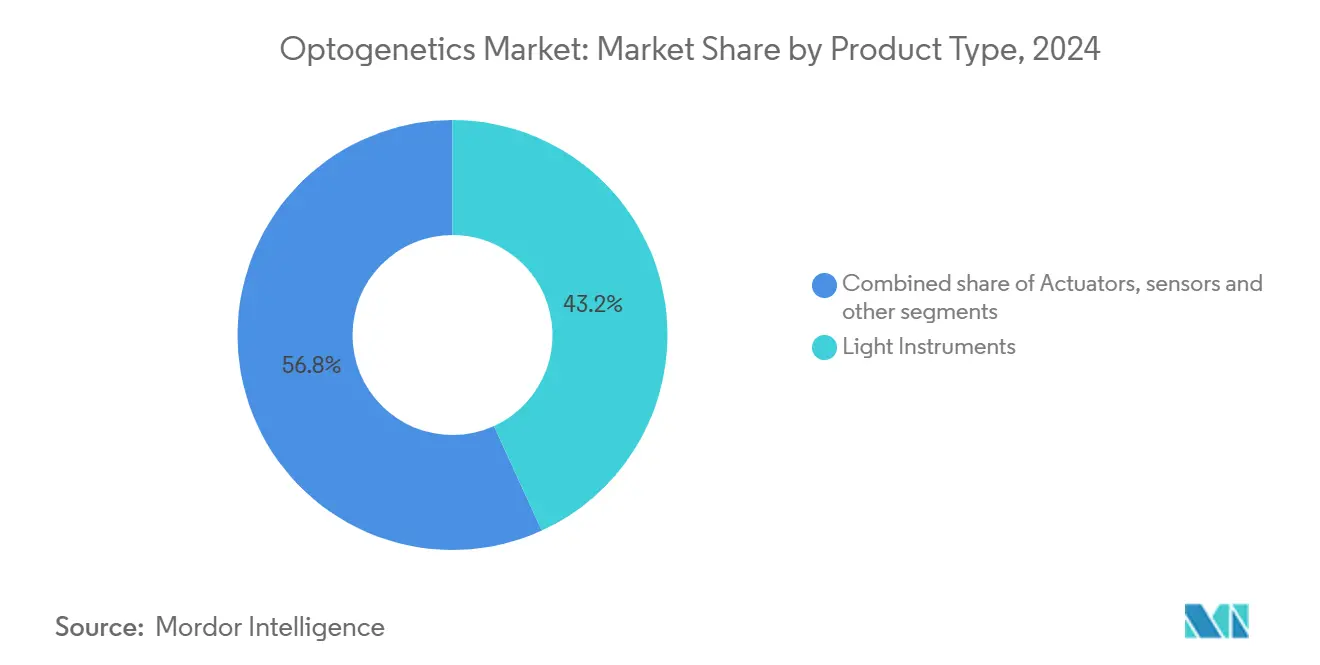
Note: Segment shares of all individual segments available upon report purchase
By Application: Neuroscience Research Retains Core Share
Neuroscience Research contributed 43.78% of the optogenetics market size in 2024 and continues to anchor baseline demand. Universities deploy optogenetic rigs to map synaptic connectivity, while pharma companies exploit the modality for target validation in psychiatric disorders. The Behavioral Tracking & Psychiatry segment achieves the fastest 4.67% CAGR as wireless head-mounted stimulators enable naturalistic assays.
Clinical translation in Parkinson’s and chronic pain drives regulatory interest and philanthropic funding. Vision-restoration trials prove the safety of intraocular opsin delivery, which derisks broader systemic applications. Cardiovascular research remains exploratory but garners attention after preclinical success in optically paced cardiomyocytes. Robust application diversity thus mitigates single-indication risk and stabilizes the optogenetics market growth trajectory.
By End User: Academia Dominates, Hospitals Accelerate
Academic & Research Institutes owned 47.32% revenue share in 2024, serving as innovation hubs that refine opsins and viral vectors. NIH and NSF grants subsidize capital purchases, ensuring steady instrument refresh cycles. Contract Research Organizations increasingly bundle optogenetic assay services, courting pharma clients that lack in-house optical capabilities.
Hospitals & Clinics show the highest 5.01% CAGR as phase-3 trials convert into commercial treatments. Early adopters establish dedicated vision-restoration suites equipped with custom light goggles and imaging units. Insurance-reimbursement pilot programs in France and Japan validate economic viability, accelerating procurement. As clinical throughput rises, instrument vendors modify industrial design to meet sterilization standards, thereby expanding the optogenetics market addressable to healthcare facilities.
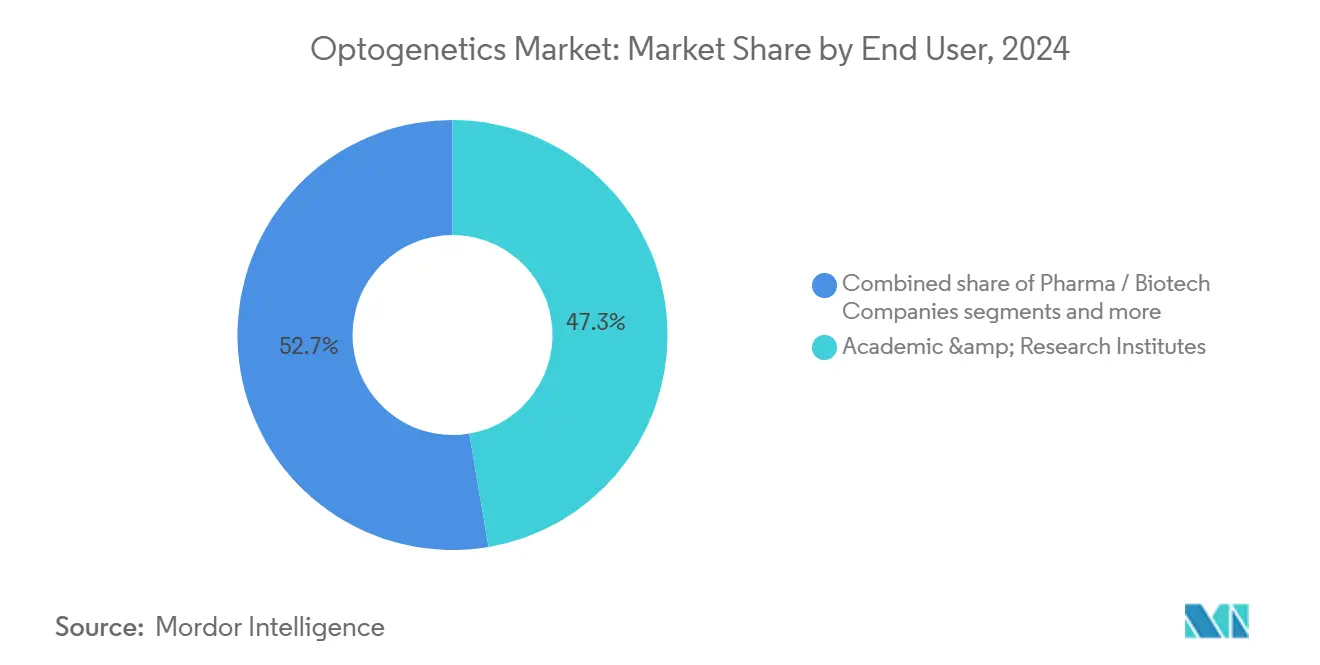
Note: Segment shares of all individual segments available upon report purchase
Geography Analysis
North America’s optogenetics market size gains from NIH BRAIN Initiative renewals, unique SBIR grants, and early clinical-trial clustering in Boston and San Diego. Canada’s Tri-Council funding stimulates cross-border academic-industry projects, while Mexico’s MedTech clusters entice U.S. suppliers aiming for cost-efficient assembly lines.
Asia-Pacific’s policy support is unmatched; Japan’s Act on Regenerative Medicine creates subsidized early-access pathways, and China’s Five-Year Plan earmarks neuroscience as a strategic pillar. Capital equipment imports in South Korea benefit from zero-tariff agreements, shortening pay-back periods for teaching hospitals. Australia’s synchrotron facilities supply advanced imaging resources that complement optogenetic workflows, allowing regional scientists to publish high-impact papers and secure further grants.
Europe balances regulatory rigor with innovation incentives; the European Innovation Council funds translational projects, while Germany’s Fraunhofer institutes collaborate with SMEs on photonic packaging. The EMA’s ATMP framework affords predictable timelines, attracting U.S. biotech firms that seek diversified approval routes. These moves maintain Europe’s relevancy even as absolute growth trails Asia-Pacific. South America invests in brain-mapping projects but still faces currency volatility that constrains capital imports. The Middle East initiates neuroscience centers of excellence within academic medical cities, yet workforce shortages slow deployment.
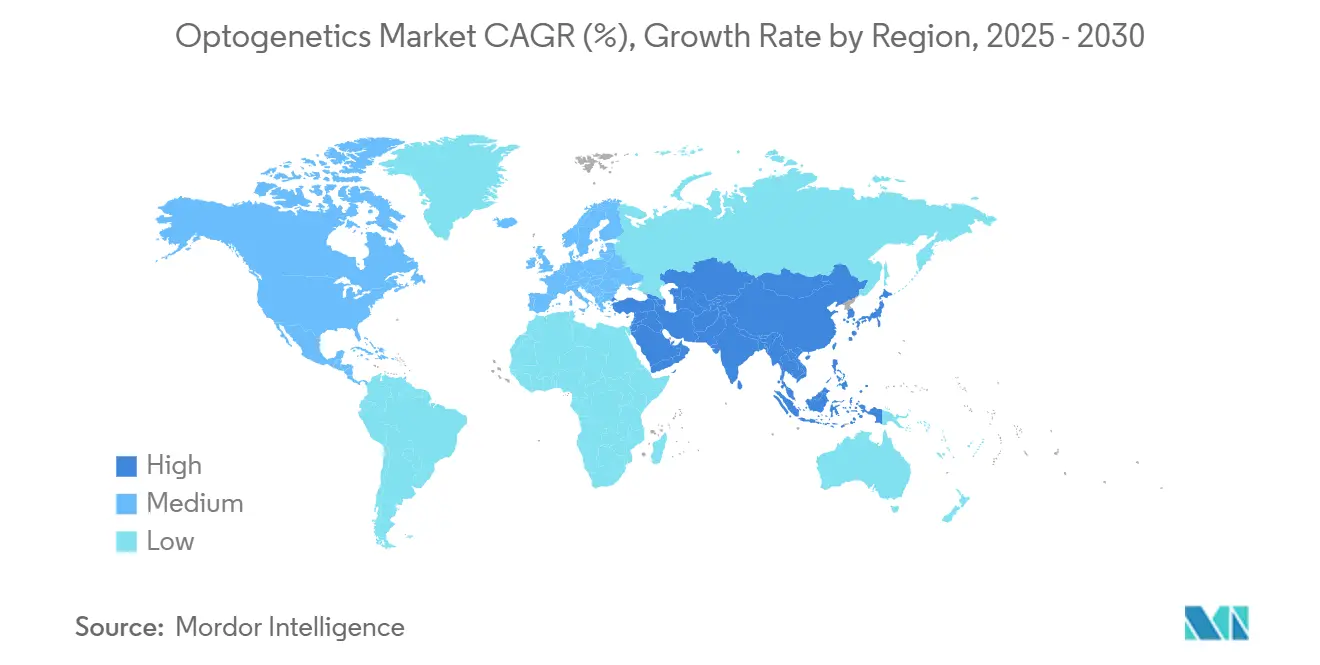
Competitive Landscape
The optogenetics market remains moderately fragmented because photonics players and biotech firms rarely overlap core competencies. Thorlabs augments vertical integration via VCSEL acquisitions to stabilize high-speed tunable-laser supply. Coherent introduces fiber-coupling modules that slot into existing Mini2P microscopes, lowering upgrade costs and locking in customers. Bruker bundles 3D holographic stimulation into its multiphoton line, aiming to own both excitation and imaging layers.
Vector manufacturers focus on yield and purity; Catalent deepens its alliance with GenSight to add European GMP capacity, reducing trans-Atlantic logistics risk. CDMOs invest in large-volume bioreactors, shaving cost-per-dose and attracting mid-cap sponsors previously deterred by price points. Start-ups explore non-viral delivery such as lipid-nanoparticle encapsulation, but scale and durability remain hurdles.
Strategically, incumbents chase platform convergence. Photonics companies venture into software analytics, while biotech firms partner with device makers for integrated clinical kits. Competitive dynamics thus revolve around ecosystem control rather than pure pricing battles. High technical barriers, proprietary opsin libraries, and regulatory know-how discourage low-skill entrants, keeping the optogenetics market attractive for specialized firms that can span at least two nodes of the value chain.
Optogenetics Industry Leaders
-
Laserglow Technologies
-
Coherent Inc.
-
Thorlabs Inc.
-
Gensight Biologics
-
Noldus Information Technology
- *Disclaimer: Major Players sorted in no particular order
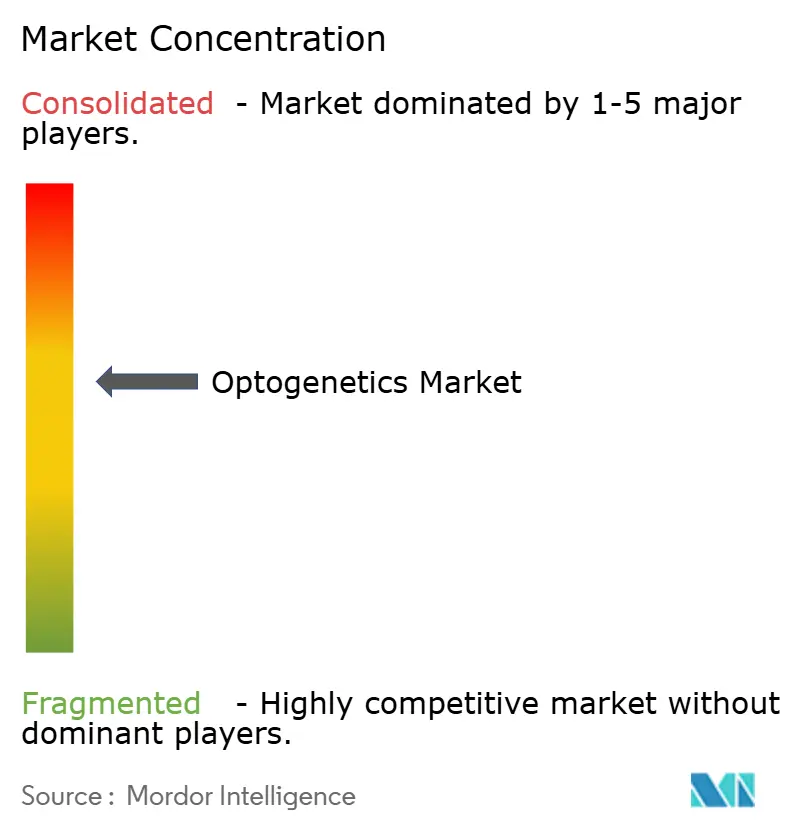


Recent Industry Developments
- June 2025: GenSight Biologics announced a milestone in its Catalent partnership, adding commercial-scale vector capacity for European launches
- April 2025: Bruker released the 2-gram nVista 2P miniature microscope, enabling deep-brain imaging in freely moving animals
Global Optogenetics Market Report Scope
As per the report's scope, optogenetics refers to a range of optical techniques used to elicit a physiological response in targeted biological systems without pharmacology and electric stimulations. Optogenetics controls neural activity by combining genetic engineering and optical tools. It is widely used in neuroscience for the modulation of neural circuits with high precision and specificity.
The optogenetics market is segmented by light equipment, actuator, sensor, application, and geography. By light equipment, the market is segmented into laser and light-emitting diodes. By actuator, the market is segmented into channelrhodopsin, halorhodopsin, and archaerhodopsin. By sensor, the market is segmented into calcium (aequorin, cameleon, and other calcium sensors), chloride (clomeleon), membrane-gated (mermaid), and other sensors. Other sensors include neurotransmitter sensors, pH sensors, and redox and metabolic sensors, among others. By application, the market is segmented into neuroscience, behavioral tracking, retinal disease treatment, and other applications. Other applications include cardiology, cellular and molecular biology, and pain research, among others. By geography, the market is segmented into North America, Europe, Asia-Pacific, Middle East and Africa, and South America. For each segment, the market size is provided in terms of USD value.
| Light Instruments | LEDs |
| Lasers | |
| Actuators | Channelrhodopsin |
| Halorhodopsin | |
| Archaerhodopsin | |
| Sensors | GECI (GCaMP) |
| VSFP |
| Neuroscience Research |
| Retinal Disorders |
| Parkinson’s & Movement Disorders |
| Behavioral Tracking & Psychiatry |
| Cardiovascular & Other Systems |
| Academic & Research Institutes |
| Pharma / Biotech Companies |
| CROs |
| Hospitals & Clinics |
| North America | United States |
| Canada | |
| Mexico | |
| Europe | Germany |
| United Kingdom | |
| France | |
| Italy | |
| Spain | |
| Rest of Europe | |
| Asia-Pacific | China |
| India | |
| Japan | |
| South Korea | |
| Australia | |
| Rest of Asia-Pacific | |
| South America | Brazil |
| Argentina | |
| Rest of South America | |
| Middle East and Africa | GCC |
| South Africa | |
| Rest of Middle East and Africa |
| By Product Type (Value, USD) | Light Instruments | LEDs |
| Lasers | ||
| Actuators | Channelrhodopsin | |
| Halorhodopsin | ||
| Archaerhodopsin | ||
| Sensors | GECI (GCaMP) | |
| VSFP | ||
| By Application (Value, USD) | Neuroscience Research | |
| Retinal Disorders | ||
| Parkinson’s & Movement Disorders | ||
| Behavioral Tracking & Psychiatry | ||
| Cardiovascular & Other Systems | ||
| By End User (Value, USD) | Academic & Research Institutes | |
| Pharma / Biotech Companies | ||
| CROs | ||
| Hospitals & Clinics | ||
| By Geography (Value, USD) | North America | United States |
| Canada | ||
| Mexico | ||
| Europe | Germany | |
| United Kingdom | ||
| France | ||
| Italy | ||
| Spain | ||
| Rest of Europe | ||
| Asia-Pacific | China | |
| India | ||
| Japan | ||
| South Korea | ||
| Australia | ||
| Rest of Asia-Pacific | ||
| South America | Brazil | |
| Argentina | ||
| Rest of South America | ||
| Middle East and Africa | GCC | |
| South Africa | ||
| Rest of Middle East and Africa | ||


Key Questions Answered in the Report
How large is the optogenetics market in 2025?
The optogenetics market size is USD 600.2 billion in 2025 with a 4.29% CAGR forecast to 2030.
Which application segment is expanding fastest?
Behavioral Tracking & Psychiatry posts the highest 4.67% CAGR through 2030, outpacing other use cases.
What region leads revenue today?
North America retains 42.03% revenue share owing to NIH funding and FDA fast-track approvals.
Where is future growth strongest?
Asia-Pacific shows the fastest 5.25% CAGR as Japan and China liberalize regenerative-medicine pathways.
What impedes wider adoption?
High capital costs for two-photon microscopes and limited viral-vector payloads constrain smaller users.
Which firms dominate instrumentation?
Thorlabs, Coherent, and Bruker hold leading positions in light-delivery and imaging components for optogenetics.
Page last updated on:
